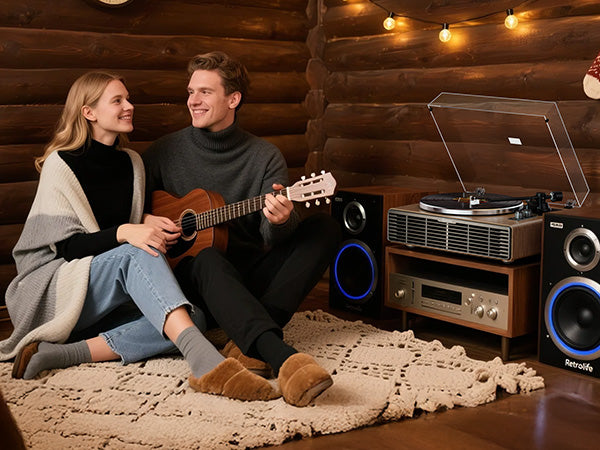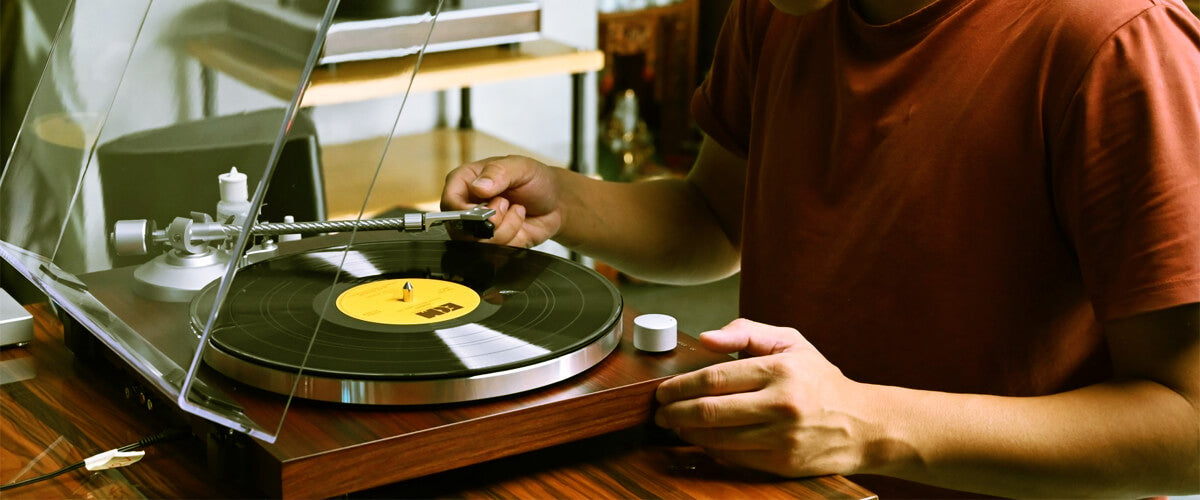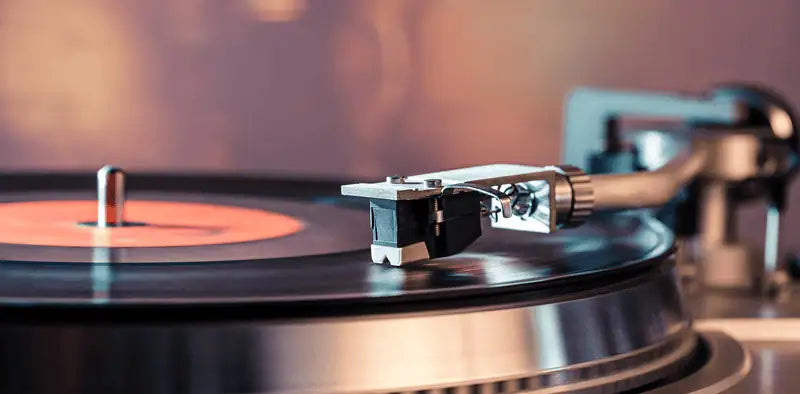So, you've embraced the world of vinyl records and have a turntable spinning your favorite albums. But plug it directly into most modern speakers or standard amplifier inputs, and you'll likely hear... very little. The signal coming directly from a turntable's phono cartridge is unique and requires specific amplification to be heard correctly. Navigating the options – phono preamps, integrated amps, receivers, powered speakers – can be confusing. While there's no single "best" way that suits everyone, understanding the different pathways to amplification allows you to choose the method that best aligns with your setup, budget, sound quality goals, and desire for convenience or flexibility. This guide explores the essential requirements and common solutions for bringing the sound of your vinyl to life.

The Unique Challenge: Why Turntables Need Special Amplification
Unlike digital sources like CD players or streamers that output a standard "line-level" signal, the electrical signal generated by a turntable's phono cartridge is exceptionally weak – thousands of times lower in voltage. It needs a significant boost to be usable by a standard amplifier or powered speakers.
Furthermore, due to the physical limitations of cutting grooves onto a record, the audio signal is intentionally altered during mastering according to a standard known as the RIAA equalization curve. Bass frequencies are reduced, and treble frequencies are boosted. This prevents bass grooves from becoming too wide and improves the signal-to-noise ratio by making high-frequency surface noise less prominent relative to the boosted treble signal. To hear the music as intended, the playback system must apply the exact inverse of this RIAA curve – boosting the bass back up and cutting the treble back down to achieve a flat frequency response.
Both tasks – boosting the low-level signal and applying the RIAA equalization curve – are performed by a crucial component called a phono preamplifier or phono stage. Every vinyl playback system requires this stage somewhere between the turntable cartridge and the main power amplifier driving your speakers.
Amplification Pathway 1: Integrated Amplifiers & Receivers with Phono Input
One of the most traditional and common solutions involves using an integrated amplifier or AV receiver that includes a dedicated "PHONO" input. An integrated amplifier combines the preamplifier section (which handles input switching, volume control, and tone adjustments) and the power amplifier section (which provides the power to drive passive speakers) into a single chassis. An AV receiver adds a radio tuner and often video switching capabilities.

When using this method, you simply connect the turntable's RCA output cables directly to the amplifier's PHONO input, and connect the turntable's ground wire to the amplifier's ground screw. The signal is then routed through the amplifier's internal phono stage for RIAA equalization and pre-amplification before being sent to the power amp section and then to your speakers. The main advantages are simplicity (fewer components and cables) and potentially cost-effectiveness, as many integrated amplifiers offer decent built-in phono stages across various price points (from brands like Yamaha, Marantz, Cambridge Audio, NAD, etc.). The primary disadvantage is that the quality of the built-in phono stage can vary greatly; in budget models, it might be a performance bottleneck. It also offers less flexibility for upgrading the phono stage independently.
Amplification Pathway 2: External Phono Preamp + Line-Level Input
If your amplifier or receiver lacks a dedicated PHONO input, or if you want to achieve potentially better sound quality than the built-in phono stage offers, using an external phono preamp is a popular and flexible solution. In this setup, the turntable connects to the external phono preamp box. This dedicated unit performs the RIAA equalization and initial signal boost. The output of the external phono preamp is now a standard line-level signal, which can be connected to any available line-level input on your amplifier, receiver, or even directly to some powered speakers (inputs labeled Aux, CD, Tuner, Tape, Line In, etc.).
The main advantages here are versatility (it allows any turntable to be used with virtually any amplifier) and upgrade potential. You can choose an external phono preamp that specifically matches your cartridge type (Moving Magnet - MM, or Moving Coil - MC, which requires even more gain) and potentially offers adjustable settings (like gain or loading) to optimize performance. Upgrading just the phono stage later can yield significant sonic improvements without replacing your main amplifier. Excellent budget options like the Schiit Mani or ART DJ Pre II exist, alongside countless mid-range and high-end audiophile units. The downsides are the addition of another component, another power supply, and another set of interconnect cables.
Amplification Pathway 3: Separate Preamp & Power Amplifier
For enthusiasts seeking the highest level of performance and system flexibility, a setup using separate components is the ultimate goal. This typically involves an external phono preamp feeding into a dedicated preamplifier (which handles only input switching, volume control, and line-level signal routing), which in turn feeds a separate power amplifier (whose sole job is to drive the speakers). This approach allows for maximum isolation between the sensitive low-level signal processing stages and the high-current power amplification stage. Each component can be optimized for its specific task with dedicated power supplies and circuitry, theoretically offering the highest potential sound quality. It also provides the greatest flexibility for component matching and future upgrades. However, this is generally the most complex and expensive pathway, requiring multiple components and interconnects, primarily pursued by dedicated audiophiles.
Amplification Pathway 4: Powered Speakers
A minimalist and increasingly popular approach involves connecting the turntable directly (or via an external phono preamp) to powered speakers. These speakers have amplifiers built directly into the speaker cabinets, eliminating the need for a separate amplifier or receiver.
For this to work seamlessly, either the turntable must have a built-in phono preamp, or the powered speakers themselves must have a dedicated phono input (which includes the necessary RIAA equalization). Some powered speakers, like certain models from Klipsch or Kanto, offer this feature. If neither the turntable nor the speakers have a phono stage, you simply insert an external phono preamp between the turntable and the powered speakers' line-level input (e.g., RCA or 3.5mm Aux). The main advantage is extreme simplicity and reduced component count, making it ideal for smaller spaces or users seeking a clean setup. It can also be very cost-effective for getting a complete, working system. The primary disadvantages are potentially limited speaker placement options (if one speaker needs to be close to the turntable for connection) and a more restricted upgrade path compared to separate components. The overall sound quality is heavily dependent on the quality of the powered speakers themselves.
Which Way is "Best"? Matching Method to Needs
There is no single "best" way to amplify a turntable; the optimal solution depends entirely on your individual circumstances and priorities.
If maximum simplicity and ease of use are paramount, especially for beginners, using a turntable with a built-in preamp connected to powered speakers, or using an integrated amplifier/receiver with a dedicated phono input, are excellent choices.
If you value flexibility and future upgrade potential on a budget, starting with an external phono preamp connected to an existing amplifier (even one without a phono input) or a quality budget integrated amplifier makes sense. You can always upgrade the phono stage or other components later.
If seeking better sound quality beyond basic entry-level, investing in a quality integrated amplifier with a well-regarded built-in phono stage, or pairing a good turntable with a capable external phono preamp and a solid integrated amplifier or receiver, is often the sweet spot.
If the goal is the absolute highest fidelity and budget/complexity are less of a concern, the path of separate phono preamp, preamplifier, and power amplifier(s) offers the most potential.

Conclusion: Convenience, Compromise & Informed Choice
Amplifying the delicate signal from a vinyl record player requires both RIAA equalization and significant gain, tasks handled by a phono preamp stage, followed by power amplification to drive speakers. Understanding the different ways these stages can be configured – within an integrated amplifier/receiver, via an external phono preamp, through separate pre/power components, or integrated into powered speakers – is key to building a system that meets your needs. Each pathway offers a unique balance of convenience, cost, flexibility, and potential sound quality. The "best" method isn't dictated by dogma, but by aligning the approach with your listening priorities, budget, existing equipment, and desire for future upgrades. By understanding these options, you can make informed choices and fully enjoy the rich, engaging experience that vinyl playback offers (making smart choices about building your ideal home audio setup is part of the journey, a topic where resources like XJ-HOME might offer further perspectives).





Leave a comment
All comments are moderated before being published.
This site is protected by hCaptcha and the hCaptcha Privacy Policy and Terms of Service apply.